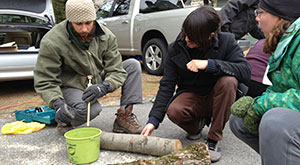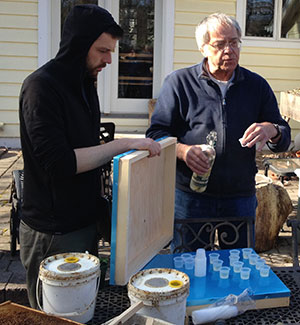Learn permaculture principles and practices on field trips to organic farms, community gardens, urban rooftop gardens and suburban installations of deer-proof organic food production across the Garden State.
Several winter classes will be held indoors in Bernardsville, NJ otherwise we'll be heading outside putting what we learn into practice in the diverse settings that the Garden State has to offer. Certifying instructor will be Wanda Knapik, with many guest speakers and organic farmers participating. Winter greenhouse work will be a real treat!
The 72-hour Permaculture Design Certification curriculum will be completed and design projects will be presented at the end of the class by all students.


It is a certificate awarded to students who attend all sessions of the design course (one missed class is allowed, there is flexibility for one make up session), and who successfully complete a design project. After completing the course, you can use the word "permaculture" in a business or other professional practice. You will join a growing global community of thousands of design-course graduates who share a common body of knowledge.
The design course is the first step in becoming a permaculture practitioner, whether in design, education, construction, gardening, farming, or any one of many other fields.
The curriculum covers diverse topics and a wide variety of subjects. You will learn practical skills and acquire tools and concepts that can be used in all aspects of life today.
In particular we will explore solutions for sustainable local food production, as well as water, and energy security. We will focus on building more resilient local communities and how to develop sustainable economic/business models. We will learn about whole-systems thinking and that the relationships between the moving parts of current natural, social, cultural and economic systems are more important than the individual components. We will look beyond sustainability, and discuss regenerative models that are not based on consumption and growth. We need to stop depleting natural resources and the human spirit and focus on renewing and reinvigorating them. The challenges of living in an industrial society can be addressed using permaculture principles, as we find ways to live in balance and more harmoniously with nature and ecological principles.
We will dive deeper into certain subjects, based on the experience level in the class and feedback on which topics are of particular interest to students. The point of the course is to introduce the relationships and synergies between the disciplines that permaculture connects. It is up to the students to continue their exploration into their areas of interest and apply permaculture principles and practices to their current life situation in a deeper way after the course is completed.



Permaculture Foundation - Introduction to permaculture; definitions; ecological design and whole systems thinking; observation skills (PATO); permaculture ethics and principles.
Patterns in Design, Pattern Literacy - Designing from patterns to details; natural patterns as a design tool; the permaculture design process; methods of design; zones and sectors.
Water Cycling and Hydrology - The water cycle; Catching and storage water; designing tanks, cisterns, rain barrels, rain gardens, irrigation systems.
Natural Water Systems - Ponds, swales, and keyline design; water in the permaculture landscape; greywater and blackwater system design; aquaponics.
Soil: The Living Skin of the Earth - Soil structure and composition; soil ecology and nutrient flow; creating healthy soil; analyzing soil; compost, nutrient teas, and mulches; cover crops and green manures.
Gardening in Small Spaces, Organic Farming and Biodynamic Practices - Home gardens; plants of many functions; monoculture vs polyculture; integrating animals and insects into the garden; pest management; wildlife habitat; pollinator gardens; healing herbs; essential oils and aromatherapy.
Food Forests, Guilds, and Ecosystems - Biodiversity; Trees and their many roles; designing plant communities; the orchard; food forest design; hedgerows, windbreaks; how ecosystems work.
Shelter, Buildings and Human Infrastructure - The functions of shelter; methods of green and natural building; living roofs; site selection; designing for disaster, Transition Town Movement.
Energy Cycling - Wind, Sun, Micro-Hydro, Geothermal energy solutions. Population, energy use, and Peak Oil; renewable energy strategies; appropriate technologies for heating and cooling, transportation, outdoor cooking, and construction.
Communities and Eco-Villages - Community dynamics; intentional communities, co-housing, and group decision-making processes; city repair; eco-villages. Designing for urban, suburban, and rural settings. Environmental Activism (anti-fracking, XL pipeline, GMO labeling, Farm Bill). Community : arts and music (the "culture" in "permaCULTURE")
Sustainable Economic/Business Models and Micro-businesses - Barter, slow money, local currency networks; permaculture in education; green business guilds and networks; building social capital. Sustainable Business Case Study: Patagonia.
The Design Project, applying what we learned: Each student can work individually or in a group to define a design project and share design solutions in a final class presentation. The designs should use fewer human resources (let nature do the work) over time, work more efficiently over time, and will be easier to maintain over time.

